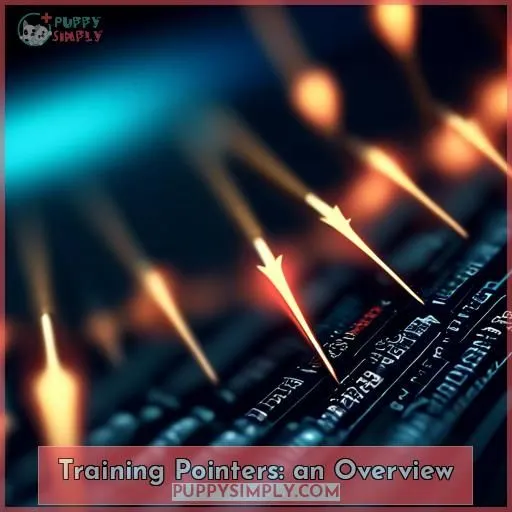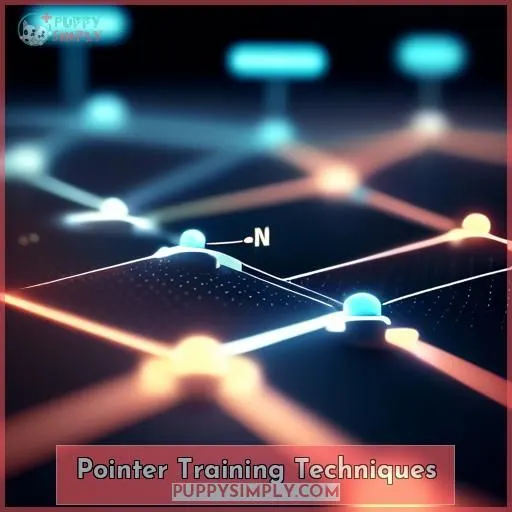This site is supported by our readers. We may earn a commission, at no cost to you, if you purchase through links.
Pointers are indeed easy to train, thanks to their high intelligence and eagerness to satisfy. Their friendly and outgoing temperament, combined with a strong prey drive, makes them receptive to positive reinforcement techniques.
However, patience and consistency are essential, as they can be obstinate at times. Regular exercise and mental stimulation are also critical for their training success.
If you’re interested in learning more about how to effectively train your Pointer, consider enrolling in obedience classes and utilizing crate training.
Table Of Contents
- Key Takeaways
- Are Pointers Easy to Train?
- Pointer Breed Origins and History
- Understanding Pointer Temperament
- Pointer Exercise Requirements
- Grooming Needs for Pointers
- Training Pointers: an Overview
- Pointer Health Concerns
- Socialization and Training Milestones
- Managing Fear Stages in Pointers
- Pointer Training Techniques
- Living With a Pointer
- Frequently Asked Questions (FAQs)
- What are the common challenges faced during Pointer dog training?
- How does the age of a Pointer puppy affect its training?
- What is the recommended approach to Pointer training, and how can it be made enjoyable for both the dog and the owner?
- How does the temperament of Pointers influence their training, and what techniques are most effective for this breed?
- What are the specific training milestones and progression for Pointers, and how can they be achieved efficiently?
- Conclusion
Key Takeaways
- Pointers are highly responsive to training and excel in obedience commands.
- Patience and consistency are essential for training Pointers, as they can be obstinate at times.
- Regular exercise and mental stimulation are crucial for their training success.
- Enrolling in obedience classes and utilizing crate training can be beneficial for training Pointers.
Are Pointers Easy to Train?
Yes, pointers are generally considered easy to train. However, their trainability can depend on factors such as their age, breed, and individual temperament. Pointers are intelligent dogs, but they can be easily distracted and stubborn, so training requires patience and consistency. Early socialization and positive reinforcement methods, such as reward-based training, can be effective in training pointers.
Pointer Breed Origins and History
Pointers, originating in England, are renowned for their exceptional pointing abilities and athletic physique. These dogs were initially bred as hunting companions, averaging 61-69 cm in height for males and 57-64 cm for females, with weights ranging from 20-30 kg. Their disposition is amiable and gregarious, with a pronounced prey drive and intelligence that renders them highly trainable.
Exercise is paramount for Pointers, requiring a minimum of 2 hours daily. Activities encompass brisk strolls, jogging, fetch, and competitive dog sports. Exercise mitigates boredom and prevents destructive tendencies. Puppies’ exercise needs differ, so consulting a veterinarian for specific recommendations is advisable.
Grooming Pointers is relatively effortless due to their short, smooth coats that necessitate regular brushing (1-2 times weekly) and moderate shedding. Bathing is required every 2-3 months.
Health considerations for Pointers include potential ailments related to bones and joints (Hip Dysplasia), eyes (Cataracts, Entropion), digestive issues (Gastric Dilation Volvulus), hormonal imbalances (Hypothyroidism), and neurological disorders (Epilepsy).
Pointers undergo socialization at 8-9 weeks, are acquainted with basic commands, and begin toilet training. Between 12-14 weeks, they’re introduced to other dogs and instructed in appropriate chewing habits. Enrolling in puppy classes is highly recommended. Fear phases are managed through appropriate responses, disregarding fear, and recognizing their transient nature.
Training strategies emphasize patience and consistency, employing positive reinforcement and commencing training promptly. Pointers are highly receptive to training and excel in obedience commands.
Understanding Pointer Temperament
You’re drawn to the pointer’s friendly and outgoing nature, but don’t let that fool you – their strong prey drive and sensitivity can pose training challenges. While affectionate and keen to satisfy, pointers are easily distracted and may exhibit reserved behavior around strangers, requiring patience and positive reinforcement during training.
Friendliness and Sociability
As a Pointer owner, you’ll quickly discover their friendly and outgoing nature. Here are four reasons why Pointers are so easy to train:
- Affectionate and Loyal: Pointers are keen to please their owners, making them highly receptive to training.
- Enthusiastic to Socialize: Pointers are friendly and sociable, which makes them great companions for children and other animals.
- Intelligent and Trainable: Their high intelligence and trainability make them quick learners, making training a breeze.
- Energy and Enthusiasm: With their boundless energy and enthusiasm, Pointers are always up for a challenge, making them responsive to positive reinforcement techniques.
Prey Drive and Distractions
Pointers are renowned for their remarkable pointing abilities. However, their pronounced hunting instinct can present hurdles in training settings.
Distractions should be skillfully managed. Focus-enhancing activities such as scent work can foster a stronger bond and enhance obedience.
Consistency in enforcing commands is paramount, even during hunting expeditions. Participating in obedience classes can be advantageous. They offer structured environments to develop prey control and distraction management techniques.
Sensitivity and Reserved Nature
While Pointers’ prey drive can lead to distractions, their sensitivity means they’re not just tough hunters. They can be a bit reserved around strangers, so it’s key to manage their anxiety with early socialization. Here’s how to navigate their delicate side:
- Introduce them to new faces gently to avoid anxiety triggers.
- Regular grooming sessions build trust.
- Teach basic commands to instill confidence.
- Understand teething can heighten sensitivity.
- Support them through fear stages; puppyhood is a journey.
Pointer Exercise Requirements
You’re in for a high-energy ride with pointers! These athletic dynamos need at least 2 hours of vigorous exercise daily – brisk walks, runs, fetch, you name it. Failing to meet their substantial exercise demands will lead to pent-up energy manifesting as destructive behaviors and incessant barking. Are you ready to keep up with this breed’s boundless stamina and enthusiasm?
Daily Exercise Activities
As a Pointer owner, you’ll need to provide your furry friend with at least 2 hours of exercise daily.
This can include activities like brisk walks, jogging, fetch, and dog sports.
The exercise duration, intensity, and location should vary to keep your Pointer engaged and prevent boredom.
For a 1-year-old Pointer, you might need to adjust the exercise frequency and variety to match their energy levels.
For 2+ year-olds, you can focus on impulse control and mental enrichment through more complex exercises.
Exercise Impact on Behavior
Exercise is vital for Pointers, who need at least 2 hours daily. Adequate exercise aids in preventing boredom and destructive behaviors. Here are three ways exercise affects behavior:
- Exercise Duration: Extended walks can alleviate anxiety and enhance focus.
- Exercise Frequency: Consistent exercise helps sustain energy levels and diminish barking.
- Exercise Intensity: High-intensity activities like fetch can stimulate the mind and improve obedience.
Grooming Needs for Pointers
Grooming a German Shorthaired Pointer is relatively easy compared to other breeds. They have a short, smooth coat that requires minimal grooming. Regular brushing once or twice a week with a firm-bristled brush or grooming mitt is sufficient to remove dirt and loose hair, stimulating the skin and promoting a healthy, shiny coat.
During shedding seasons, increase brushing to a few times per week to help manage the excess hair. Bathing can be done every three to four months, or as needed, depending on their activity level and lifestyle. Use a mild, dog-specific shampoo to avoid stripping their coat of natural oils.
Ear cleaning should be done weekly to prevent wax buildup and ear infections. Nail trimming can be done monthly or as needed to keep them short and prevent discomfort while walking.
Coat Maintenance
Pointer breeds are known for their sleek and athletic build. Their short, smooth coats require minimal grooming, but regular brushing (1-2 times per week) is necessary to maintain the coat’s health and appearance. Pointers are moderate shedders, so bathing is only needed every 2-3 months.
Potty training and basic commands are essential to implement early on in a puppy’s life. While grooming is important, it’s also crucial to focus on these fundamental training aspects.
Shedding and Bathing
Pointers are known for their short, smooth coats that require minimal grooming. They shed a small amount of hair year-round, which is manageable with regular brushing. Here are some tips for managing their shedding and bathing needs:
- Brush regularly: Brushing once a week with a bristle brush or rubber hand mitt can help remove dead fur and promote a healthier coat that sheds less.
- Bathe as needed: A good bath once or twice a month, depending on the type of Pointer, can help remove old fur and loosen it before brushing.
- Use appropriate products: When bathing, use a good dog shampoo and avoid over-bathing, as this can dry out their skin and hair, making shedding worse.
- Seasonal grooming: Some Pointers, like the German Shorthaired Pointer, are seasonal shedders and may require more frequent grooming during heavy shedding periods.
- Monitor shedding: Keep an eye on your Pointer’s shedding habits, as excessive shedding can be a sign of underlying health issues, such as diabetes, liver disease, or cancer.
Training Pointers: an Overview
Yes, Pointers are generally easy to train. They’re highly receptive to positive reinforcement training and respond well to patient obedience training. However, they can be stubborn and easily distracted, so it’s important to be consistent and persistent in your training efforts.
Commands such as down and stay are important to teach, and gentle corrections may be necessary. Pointers are also sensitive, so it’s important to use positive reinforcement and avoid punishment, which can increase anxiety and undermine their trust in you.
Importance of Patience and Consistency
Regarding Pointer training, patience and consistency are paramount. These dogs are clever and trainable, but they can also be headstrong and readily distracted. To attain successful training outcomes, it’s crucial to remain patient and unwavering in your instructions.
Employ positive reinforcement methods, such as rewards or commendations, to incentivise desirable actions. Bear in mind that training a Pointer requires time and dedication, but the benefits are substantial.
Dealing With Stubbornness
Dealing with stubbornness is a common challenge in pointer training. Remember, patience and consistency are key. When your pointer is being stubborn, don’t let it distract you from the goal. Instead, focus on reward sensitivity and command consistency.
If your pointer is easily distracted, use distraction control techniques to refocus its attention. Every dog is unique, so be patient and keep trying different methods until you find what works best for your pointer.
Pointer Health Concerns
Pointers are renowned for their exceptional pointing abilities, but they also encounter diverse health concerns. Several of the most prevalent health issues include:
Hip dysplasia
Cataracts
Entropion
Gastric dilation volvulus
Hypothyroidism
Epilepsy
As a conscientious pet guardian, it’s imperative to be cognizant of these potential health problems and collaborate closely with your veterinarian to safeguard your pointer’s health and well-being.
Bones and Joints
As a pointer owner, you may be aware that your breed is prone to joint issues, including hip and elbow dysplasia. These conditions can cause pain, lameness, and arthritis in your dog. Hip dysplasia is a developmental abnormality in the elbow joint, while elbow dysplasia involves abnormal bone growth, cartilage development, or joint stresses. Both conditions can lead to joint pain and mobility issues.
To help your pointer maintain healthy joints, consider the following tips:
- Maintain a healthy weight: Overweight dogs put extra strain on their joints, which can exacerbate existing conditions. Make sure your dog is at an ideal weight to reduce the risk of joint problems.
- Exercise appropriately: High-impact activities, such as jumping and running, can put stress on your dog’s joints. Opt for low-impact exercises like swimming or short walks to keep your pointer active without causing joint damage.
- Provide joint supplements: Joint supplements containing glucosamine and chondroitin can help support your dog’s joint health and reduce inflammation.
- Consider specialized diets: Feeding your dog a diet specifically formulated for large breeds can help prevent excessive growth, which can lead to skeletal disorders like hip and elbow dysplasia.
Eyes
Your Pointer’s eyes are a vital aspect of their well-being. Monitor them for concerns such as cataracts, entropion, or dry eye. Regular grooming around the eyes is imperative, along with checking for any indications of discomfort or irritation. Vision care is also essential, guaranteeing they’ve an unobstructed view of their surroundings.
Gastrointestinal
Gastrointestinal Health Concerns in Pointers
Pointers are prone to several gastrointestinal health issues, including bloating and digestive problems. Here are some key points to bear in mind:
- Gastric Dilatation-Volvulus (GDV): Also known as bloat, this condition occurs when the stomach fills with gas, putting pressure on the organs and potentially causing blood flow to be blocked.
- Nutritional Sensitivity: Pointers may have food intolerances or allergies, which can lead to digestive problems.
- Dietary Restrictions: Some Pointers may require dietary restrictions due to food allergies or sensitivities.
- Meal Management: Feeding Pointers smaller, more frequent meals can help prevent bloat and ensure proper digestion.
- Consult with a Veterinarian: Always consult with a veterinarian for specific dietary recommendations based on your Pointer’s individual needs and health concerns.
To maintain your Pointer’s gastrointestinal health, ponder the following tips:
- Feed Small, Frequent Meals: Breaking up meals into smaller portions can help prevent bloat and ensure proper digestion.
- Slow Down Eating: Using slow feeder bowls or adding large rocks to the bowl can help your Pointer eat more slowly, reducing the risk of bloat.
- Monitor Food Intolerances: Keep an eye on your Pointer’s reaction to different foods and consult with a veterinarian if you suspect an allergy or sensitivity.
- Regular Check-ups: Schedule regular veterinary visits to monitor your Pointer’s overall health and address any gastrointestinal concerns.
Hormonal
Regarding your Pointer’s health, hormonal issues can disrupt its well-being. Thyroid problems and endocrine disorders are common culprits, frequently resulting in a lethargic or overweight companion. Reproductive health and adrenal gland issues can also emerge, so remain vigilant for any hormonal imbalances that may require veterinary attention.
Neurological
Neurological issues in Pointer breeds can affect their cognitive function, behavior patterns, and brain development. Understanding these issues is paramount for providing appropriate care and training for your Pointer. Some common neurological concerns include:
- Cognitive Dysfunction Syndrome (CDS): This condition, also known as doggy Alzheimer’s, affects older dogs and can cause memory loss, confusion, and behavioral changes.
- Seizures: Pointers are prone to seizures, which can be caused by various factors such as genetics, infections, or metabolic disorders.
- Brain Tumors: These can cause a range of symptoms, including seizures, behavioral changes, and vision or hearing problems.
- Neurological Disorders: Pointers are susceptible to a variety of neurological disorders, including degenerative myelopathy, which affects the spinal cord, and progressive retinal atrophy, which can lead to blindness.
To address these issues, it’s imperative to collaborate closely with your veterinarian to monitor your Pointer’s health and adjust their training and exercise regimen as required. Regular check-ups and preventative care can help mitigate the risk of neurological problems.
Socialization and Training Milestones
As you commence the adventure of nurturing your Pointer, it’s essential to recognize the pivotal milestones in their familiarization and education. From welcoming them to your abode at 8-9 weeks to expanding their expertise beyond 6 months, each phase holds paramount importance in molding their conduct and capabilities.
8–9 Weeks
At 8-9 weeks, your pointer puppy is ready to join your family. Start socializing them with people, introduce grooming, and begin basic commands. Schedule vet appointments for vaccinations and discuss nutrition needs. Introduce crate training for a safe space and potty training. Remember, early socialization is essential for a well-rounded pup.
12–14 Weeks
At 12-14 weeks, your Pointer’s socialization schedule is critical. Temperament development is paramount. Breed-specific training, puppy socialization tips, and fearful behavior management are indispensable. Engage in quiet nights, teach acceptable chewing, and enroll in puppy classes. Be aware of fear stages. React appropriately, ignore fear, and remove from situations. Fear stages won’t last forever.
4 Months
At 4 months, your pointer puppy is ready for advanced training. This is the perfect time to focus on obedience commands and start working on recall.
It’s also essential to continue socialization, ensuring your puppy is comfortable around different people and animals. Remember, consistency is key in training.
Don’t forget to provide a balanced diet and regular health screenings to support your pup’s development.
6 Months and Beyond
As your Pointer pup hits the 6-month mark, you’re steering into the adolescence phase—think of it as the teenage years for dogs. It’s essential to maintain a firm grip on training to prevent boredom and manage that signature stubborn streak. Here’s how to navigate this period:
- Channel their excitability into challenging games that build confidence.
- Overcome distractions with consistent, engaging training sessions.
- Tackle stubbornness with firm, yet playful commands.
Managing Fear Stages in Pointers
Regarding managing fear stages in Pointers, comprehending the breed’s temperament and responding suitably can profoundly impact their overall well-being. Pointers are renowned for their amiable and outgoing nature, but they can also be vulnerable and easily sidetracked. This combination can result in fear triggers that might necessitate desensitization methods and socialization exercises to assist them in overcoming their fears.
Desensitization methods involve progressively exposing the Pointer to the feared object or scenario in a controlled and relaxed setting. The process marries relaxation techniques with a hierarchical exposure to the anxiety-inducing stimulus, enabling the individual to confront and mitigate their fear without an anxiety response. For example, if a Pointer is apprehensive of loud noises, the owner might commence by playing gentle music and incrementally increase the volume, while utilizing relaxation techniques to assist the dog in feeling more at ease.
Socialization exercises are also essential for managing fear stages in Pointers. These exercises involve exposing the dog to diverse environments, individuals, and other animals in a controlled manner. This aids the dog in becoming more confident and less apprehensive in various situations. For instance, taking the Pointer to a dog park or a crowded street with an abundance of people and other dogs can assist them in acclimating to these environments and reducing their fear of novel situations.
Calming signals are another significant aspect of managing fear stages in Pointers. These signals, such as yawning, blinking, or averting their gaze, can help the dog feel more relaxed and less anxious. By recognizing and responding to these signals, owners can assist their Pointers in feeling more comfortable and less apprehensive in new situations.
Pointer Training Techniques
To effectively train your Pointer, consider using positive reinforcement techniques, crate training, and enrolling them in obedience classes. By implementing these methods, you’ll foster a strong bond with your dog and help them reach their full potential.
Positive Reinforcement
Positive reinforcement is a potent resource in the realm of canine training, and it’s especially efficacious in regard to the pointer breed. This method entails employing rewards, such as treats or praise, to foster desirable behaviors and dissuade undesirable ones. The principle is to strengthen the behaviors you seek to foster, making them more likely to be replicated in the future.
To wield positive reinforcement effectively, you must associate a signifier, such as a clicker, with a reward. This can be accomplished through a process known as loading the clicker, whereby you click and forthwith provide a treat. After approximately 10-20 repetitions, your dog will comprehend that the click portends an impending reward. This can be utilized in diverse training contexts, such as lure-and-reward training, molding behaviors, capturing positive behavior, or even instructing tricks.
Crate Training
Crate training is an important part of your Pointer’s early life. It provides a secure space for your pup, assists with house training, and minimizes destructive behaviors. Commence crate training at 8-9 weeks, progressively increasing the time spent in the crate. Adhere to a consistent schedule, ensuring your Pointer becomes accustomed to the crate.
Crate training is beneficial for your Pointer’s well-being and training progress.
Obedience Classes
Enroll your Pointer puppy in obedience classes, beginning at puppy kindergarten. Socialization is of utmost importance, and obedience curriculum can assist with fundamental commands. Specialized training for your breed can make a significant impact. Obedience classes provide a controlled setting for your Pointer to learn and mature, creating a robust connection between you and your canine companion.
Living With a Pointer
Living with a Pointer can be a rewarding experience, as they’re known for their friendly, outgoing, and affectionate nature. However, their high exercise requirements and strong prey drive can pose challenges for some owners.
Exercise and Mental Stimulation
As a Pointer owner, you’ll quickly learn that exercise and mental stimulation are vital for maintaining your furry friend’s contentment and good behavior. Bear in mind, a fatigued dog is a well-behaved dog!
Engage in off-leash training, bird training, agility training, and nose work to keep your Pointer’s mind engaged and body active. Regular exercise not only alleviates tedium but also aids in managing their strong prey drive.
With an appropriate balance of physical and mental stimulation, your Pointer will be a well-rounded, obedient companion.
Pointers in the Home Environment
Living with a pointer can be a joyful experience. Pointers are known for being friendly and outgoing, making them great companions for families. They’re also generally good with children, which is a significant advantage for families with young kids.
However, pointers can suffer from separation anxiety, which can lead to destructive behavior. To prevent this, make sure they get enough exercise and mental stimulation. Indoor activities like fetch or dog sports can help keep them engaged and reduce destructive behavior.
Frequently Asked Questions (FAQs)
What are the common challenges faced during Pointer dog training?
Common challenges faced during Pointer dog training include:
- Puppy Training: Puppies have different exercise requirements and training needs than adult Pointers. They require socialization, basic obedience training, and potty training.
- Distractibility: Pointers are easily distracted, which can make training more challenging. They may not always focus on the task at hand, which can lead to inconsistencies in their training.
- Stubbornness: Pointers can be stubborn, which may require patience and gentle corrections during training.
- Fear Stages: Puppies go through fear stages, which can affect their training. Ignoring fear and removing them from the situation is essential during these stages.
- Man-Made Faults: Overuse of training tools like e-collars, working on too many areas of training at once, and not remembering that hunting should be fun for the pup can cause man-made faults in the dog.
- Underhandling and Overhandling: Mismanaging control can lead to issues in handling and control. Underhandling can result in a dog ignoring the handler, while overhandling can cause the dog to become too dependent on the handler.
- Handling in the Field: Inexperienced dogs may struggle with handling in the field, which can affect their ability to hunt and respond to commands.
- First Season Challenges: Handling and control issues are common during the first season, which can be demanding for both the dog and the handler.
To overcome these challenges, it’s imperative to understand the breed’s characteristics, be patient, and use positive reinforcement techniques. Training should be tailored to the dog’s temperament and ability, and it’s vital to remember that training is an ongoing process.
How does the age of a Pointer puppy affect its training?
Training a Pointer puppy is like sculpting a masterpiece; age is your chisel. Start at 8-9 weeks for a malleable mind, but remember, even at the teen stage, patience turns challenges into triumphs.
What is the recommended approach to Pointer training, and how can it be made enjoyable for both the dog and the owner?
Training a pointer is a rewarding experience when approached with the right techniques and patience. The recommended approach involves starting training early, beginning with basic commands and potty training. Socialization with other dogs and people is vital for a well-rounded pup.
Positive reinforcement is key, using treats, praise, and clickers to encourage desired behaviors. Consistency and patience are essential, as pointers can be stubborn and easily distracted.
Make training enjoyable for both you and your dog by incorporating fun activities like retrieval games and water exercises. Remember, every dog is unique, so tailor your training methods to suit your individual pet’s needs and personality.
How does the temperament of Pointers influence their training, and what techniques are most effective for this breed?
Pointers are known for their intelligence, willingness to obey, and friendly temperament, which makes them easier to train than some other breeds. However, they can be stubborn and easily distracted, so patience and consistency are key. Training should be positive and reward-based, with immediate feedback and gentle corrections.
What are the specific training milestones and progression for Pointers, and how can they be achieved efficiently?
Pointers are renowned for their intelligence and keenness to learn, rendering them relatively effortless to train. However, their high energy levels and potent prey drive necessitate a consistent and patient approach to training. To attain efficient training milestones, adhere to these steps:
- Start early: Commence training at 8-9 weeks, emphasizing basic commands like sit, stay, and come.
- Socialize your puppy: Familiarize them with diverse environments, people, and other animals to aid in developing confidence and acquiring appropriate behavior.
- Employ positive reinforcement: Reward your puppy with praise, treats, or playtime when they exhibit the desired behavior.
- Maintain training sessions brief and engaging: Aim for 10-15 minute sessions, 2-3 times a day.
- Exercise patience: Bear in mind that your puppy is still learning and may not master everything immediately.
- Set attainable expectations: Celebrate modest milestones along the way and anticipate gradual progress.
- Forgo punishment-based training: Focus on positive reinforcement and redirection to cultivate a trusting relationship with your puppy.
- Impart essential commands: Leave it and Drop it are indispensable for thwarting undesirable behaviors and potentially perilous situations.
- Consistency is paramount: Ensure that everyone in your household employs the same commands and rewards to minimize confusion.
- Maintain ongoing training: Training is an enduring process, and you can continue to work on new skills as your puppy matures.
Conclusion
In the realm of canine lineages, pointers are frequently lauded for their amenability to instruction. Their keen intellect and zeal to gratify make them indeed effortless to train.
Nonetheless, it’s paramount to bear in mind that forbearance and constancy are indispensable. Regular exertion and cognitive stimulation are also sine qua non for their training to bear fruit.
Enlist in obedience classes and employ crate training to further augment their educational odyssey.

















